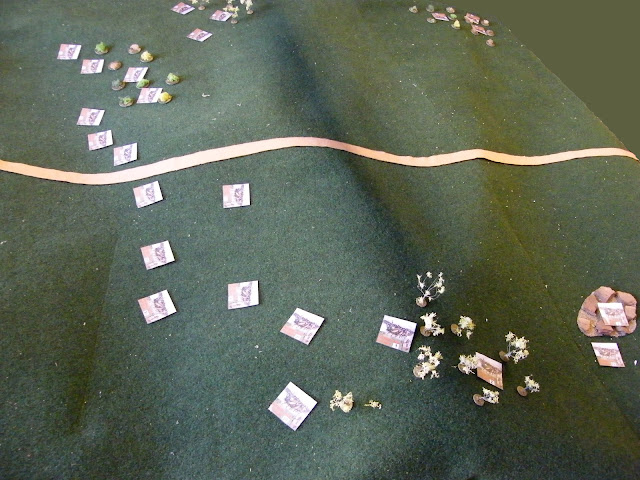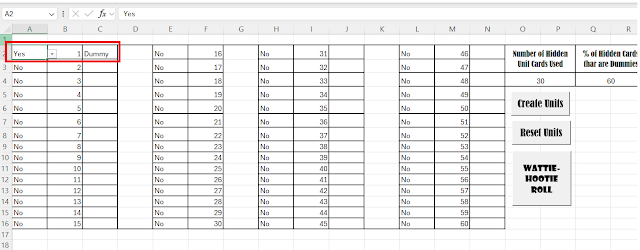Today I thought I'd present a solo game aid that was a little more of a solo game aid. My first solo "The Sword and the Flame" game, "Disaster at Gakdul Wells", featured an Egyptian force in a makeshift fort being attacked by a bunch of Dervish. As such, there were no hidden unit needed, the Dervish just came blazing down the hills at the fort.
For my next game, I am doing a British supply column crossing through hostile territory in Zululand. For this action, I would like to have the Zulus represented by hidden unit markers so that I do not know if the position occupied by the marker is a real unit or a dummy marker.
To accomplish this, I have created another spreadsheet. It will allow me to use up to 60 hidden unit markers. I can enter the number of markers I want to use and a percent value for the number of dummy markers.
For my game, I am using two platoons of infantry, a troop of Natal Mounted Police, and a unit of hussars. For this force of four units there should be about twelve Zulu units. With that, I set the number of unit markers to 30 and the percent of dummy markers to 60. This should give me somewhere around the twelve actual units called for.
Next, I click the Create Units button. This starts the routine that writes the status of each marker to a hidden worksheet. Here is an example of the data generated.
The unit marker is number 1, so I click in cell A2 (for this group of cells, the B column indicates the hidden unit card number) and set it to "Yes". In this case, the card is a dummy unit marker.
When unit marker 4 was spotted, it turned out to be a real Zulu unit. I place Zulu unit 4 on the table, in the spot where its marker is. Then I click the Wattie-Hootie Roll button.
What is a "Wattie-Hootie Roll"? Well, when playing a game with unit markers, it would be all to easy to just isolate 1 marker at a time and blast it away. What the "Wattie-Hootie Roll" does is to give a radius from the discovered unit and any unit cards within that radius are activated as well.
In this example, the "Wattie-Hootie Roll" says any cards within 12" are activated as well.
If unit 4 is the rightmost unit circled above, then the two markers next to it would be revealed. Should one or both of those markers be actual units, another "Wattie-Hootie Roll" would be made, and the radius is measured from the newly revealed unit. In this way, hidden units may get support from nearby friends. It might also spring an ambush prematurely.
I have placed the Hidden Unit Generator on my Google drive for those who want it. If you have any difficulty downloading the file, please let me know.
Thank you and happy gaming!














That's a beaut player aid Chris. Your table and figures look just grand too.
ReplyDeleteIf you are a bit of a hobby programmer, have a look at scripting, if you do not already do it. Computer applications like 'Visual Studio Code', allow you to lay out the script simply and clearly and there is a whole world of examples and help sites for scripting languages like java script or angular. Then there is 'R', nominally for statistics, but in reality a 'language' with which you can create infinite scripts and applications. There is a huge community of devotees making scripts and examples to try.
Regards, James